When it comes to managing orders, spreadsheets and manual workflows simply don’t scale. In industries like retail, e-commerce, logistics, and manufacturing, the lack of a centralised system often leads to shipping delays, stock mismatches, and frustrated customers. That’s because order management isn’t just about shipping — it’s about overseeing the entire order lifecycle, from the moment a purchase is made to the final delivery (and sometimes returns).
A well-built Order Management System (OMS) brings automation, visibility, and structure to every step. For many growing companies, off-the-shelf OMS platforms are too rigid or complex, which is why more businesses are choosing to develop a custom order management system tailored to their unique workflows, integrations, and growth plans.
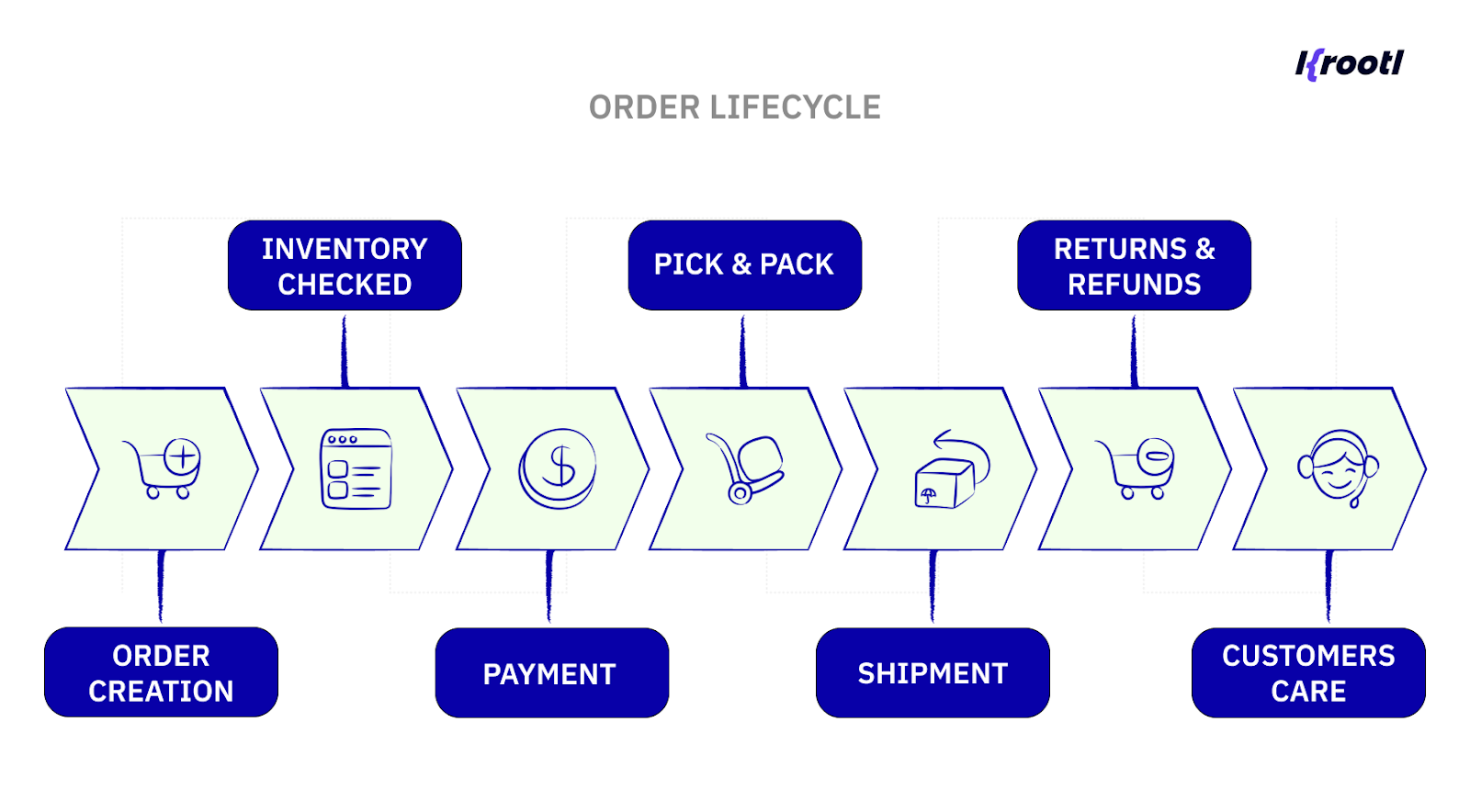
In this article, we’ll break down what an OMS actually does, who uses it, the problems it solves, and when it makes sense to go custom including when to develop a mobile order management app.
What Is an Order Management System?
A custom order management system is software that helps businesses track and manage the entire journey of a customer order from placement to delivery and everything in between. It acts as a central operations hub, connecting your sales channels (e.g., Shopify, marketplaces, POS systems) with real-time inventory, automated fulfillment, and proactive customer communication.
Here’s how a typical order lifecycle works when an OMS is in place:
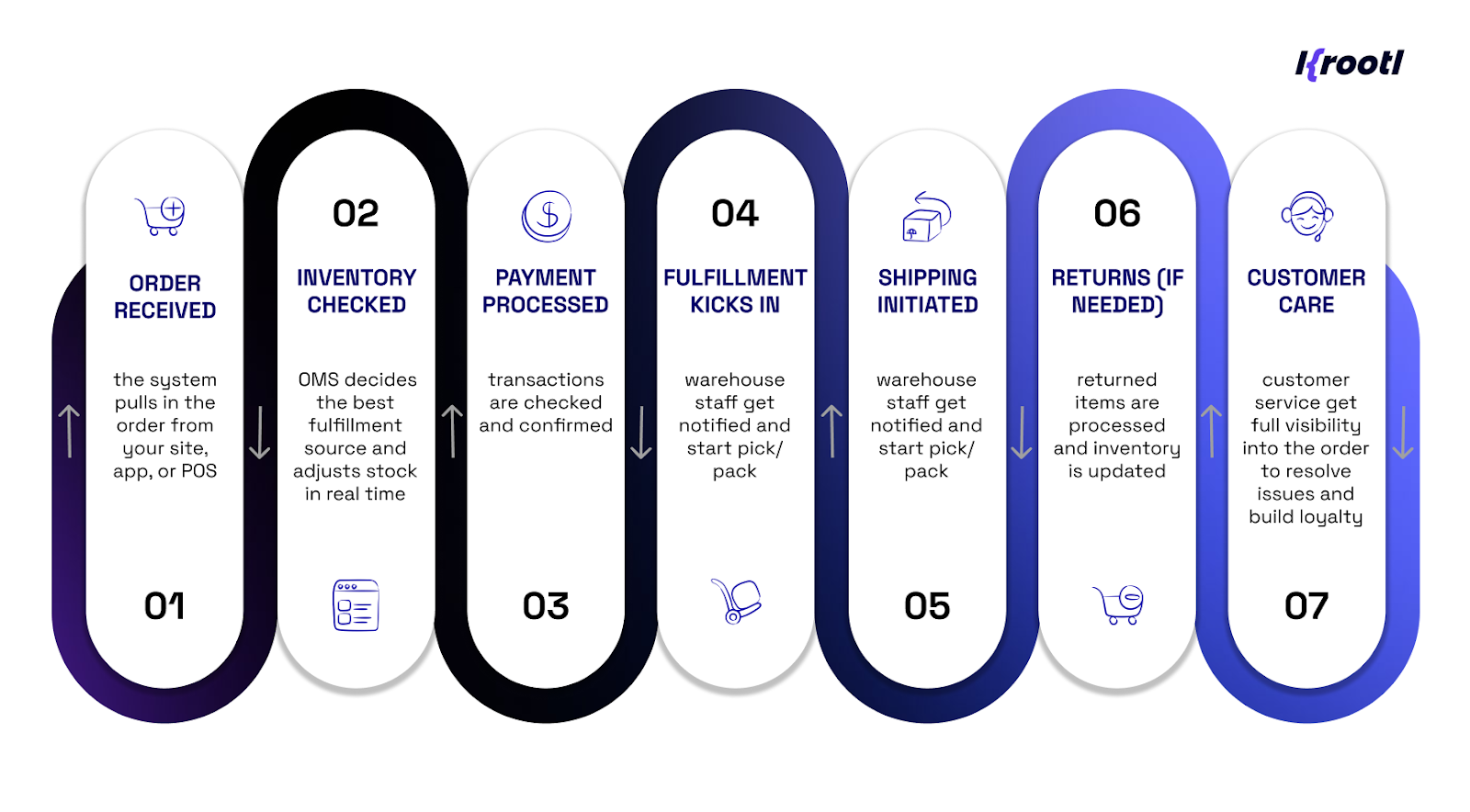
With the right OMS, this process is faster, more accurate, and scalable allowing you to manage higher order volumes without losing control.
Who Actually Uses Order Management Systems?
Order Management Systems aren’t just for enterprise giants. Any business that handles a high volume of orders, works across multiple sales channels, or wants to streamline fulfillment can benefit from an OMS. Below are the industries where a custom order management system can have the biggest impact.
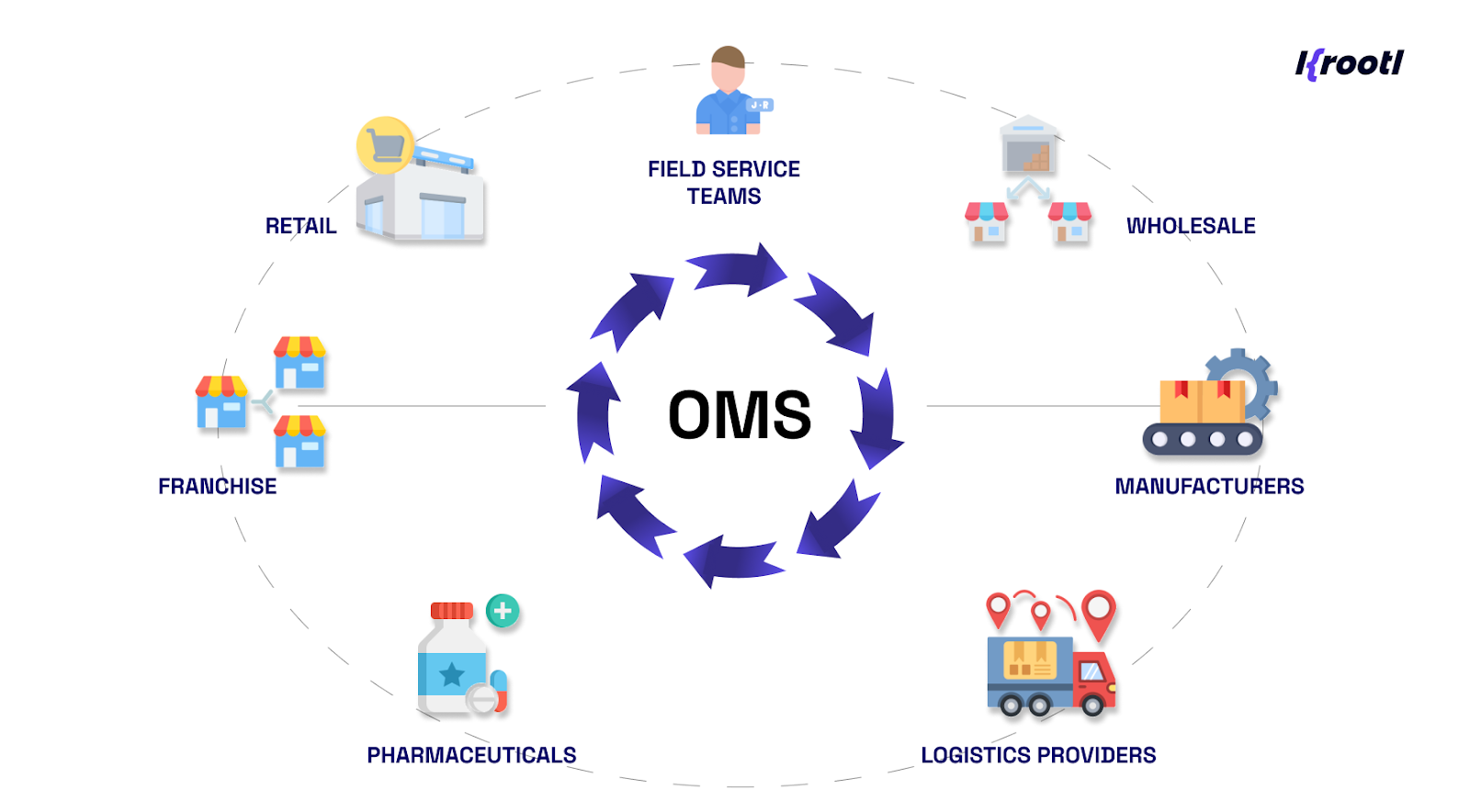
1. Retail & E-commerce
Retailers and online sellers can use a custom OMS to sync inventory across online stores, marketplaces, and physical locations. It ensures accurate stock levels, routes orders to the best fulfillment center, and reduces overselling.
2. Wholesale & Distributors
Wholesale and distribution companies can improve efficiency with an OMS that handles large-scale orders, manages B2B pricing, and coordinates bulk shipments. Integrations with ERP systems help avoid manual errors and speed up processing.
3. Logistics Providers & 3PL (Third-Party Logistics)
Logistics companies benefit from delivery application development integrated with an OMS, enabling real-time order tracking, route optimization, automated label printing, and instant status updates.
4. Manufacturers
Manufacturers can link production schedules with real-time order data to manage raw materials, track made-to-order products, and streamline partial shipments. This makes it easier to adapt production to demand changes.
5. Franchise Businesses
Franchise operations can maintain consistent pricing, inventory, and order workflows across multiple locations with a custom order management system. It also provides central oversight for better reporting and quality control.
6. Healthcare & Pharmaceuticals
Healthcare and pharmaceutical companies use OMS platforms to track lot and batch numbers, manage expiry dates, and ensure compliance with strict industry regulations.
7. Field Service Teams
Field service teams can especially benefit from developing a mobile order management app. This allows them to create orders, capture customer signatures, update inventory, and process payments directly from a mobile phone or tablet — keeping work moving without returning to the office.
Discover how we optimised the supply chain with a distribution management app for an FMCG manufacture.
Why Businesses Use an Order Management System: Problems It Solves
Managing orders manually might work in the early days, but as sales grow, the complexity grows even faster. Coordinating the full order lifecycle from quote to delivery across multiple channels without a centralized system often leads to errors, delays, and unhappy customers.
Without an order management system, businesses typically face:
- Shipping errors or missing items in orders
- Inventory mismatches that cause overselling or excess stock sitting in warehouses
- Fulfillment delays due to poor coordination between sales, warehouse, and logistics teams
- Frustrated customers caused by inconsistent updates, missed deadlines, or inaccurate tracking
- Limited visibility into what’s ordered, shipped, returned, or refunded
- Manual errors in order entry and invoicing
How a Custom OMS Solves These Challenges
A custom order management system doesn’t just fix operational pain points but it actively improves how the business runs:
Real-time visibility – Get up-to-date stock levels, order statuses, and customer activity to make faster, data-driven decisions.
Higher accuracy – Automation reduces manual entry mistakes, order mismatches, and communication gaps.
Streamlined operations – Manage inventory, sales, fulfillment, and finance in one platform
Faster fulfillment – Automated order routing, inventory allocation, and processing speed up delivery times.
Improved customer experience – Provide accurate delivery times, real-time tracking, and proactive updates to boost loyalty.
Scalability – As the volume grows, the OMS scales without adding headcount or overhead.
Off-the-Shelf vs. Custom Order Management System — Which One Should You Choose?
Once you understand how an order management system works, the next step is deciding whether to choose an off-the-shelf OMS or develop a custom order management system. Both options have their advantages, but the right fit depends on your workflows, integration needs, and growth plans.
Off-the-shelf OMS platforms (like Odoo, SAP, or Zoho Inventory) are built with standard features to suit a broad audience. They’re quicker to implement and often come with reliable support, but they may require workarounds or extra tools to fit your exact needs.
Custom OMS solutions, on the other hand, are designed specifically for your business built from the ground up to match how your teams actually operate. You decide what features are included, how the interface works, and which systems it integrates with.
If you’re a growing company with unique fulfillment flows, multi-channel sales, or specific automation goals, custom development may bring long-term advantages. But it does come with a higher upfront investment and a longer build cycle.
Let’s break it down:
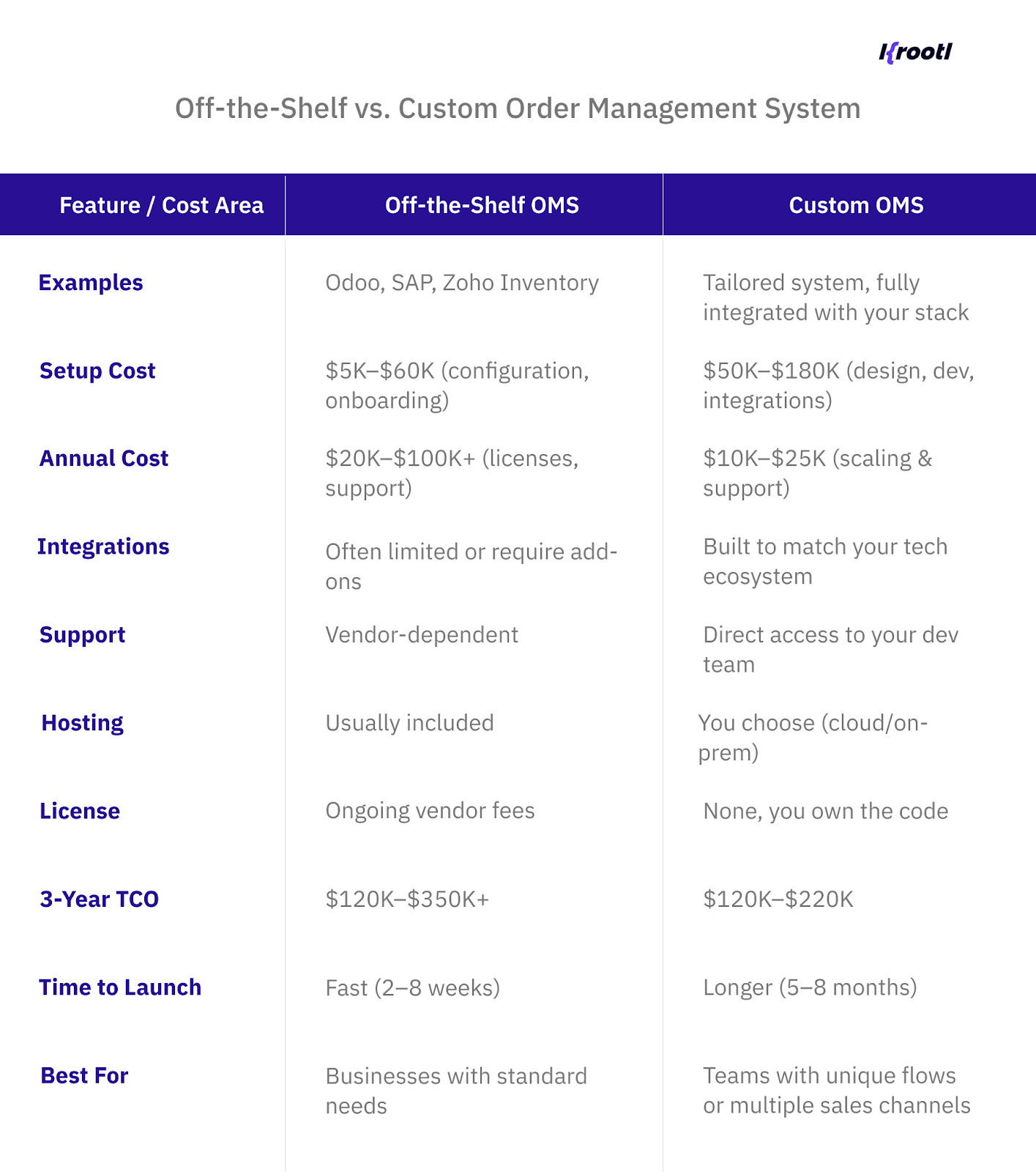
The key thought here is if your workflows are simple and speed is the priority, a ready-made platform can do the job. But if your operations are layered or you want control and flexibility then a custom order management system pays off long term.
Key Integrations to Consider in a Custom Order Management System
Whether you choose an off-the-shelf OMS or develop a custom order management system, the real power comes from how well it integrates with the rest of your business tools. An OMS that operates in isolation can’t deliver the full benefits of automation, real-time visibility, and operational efficiency.
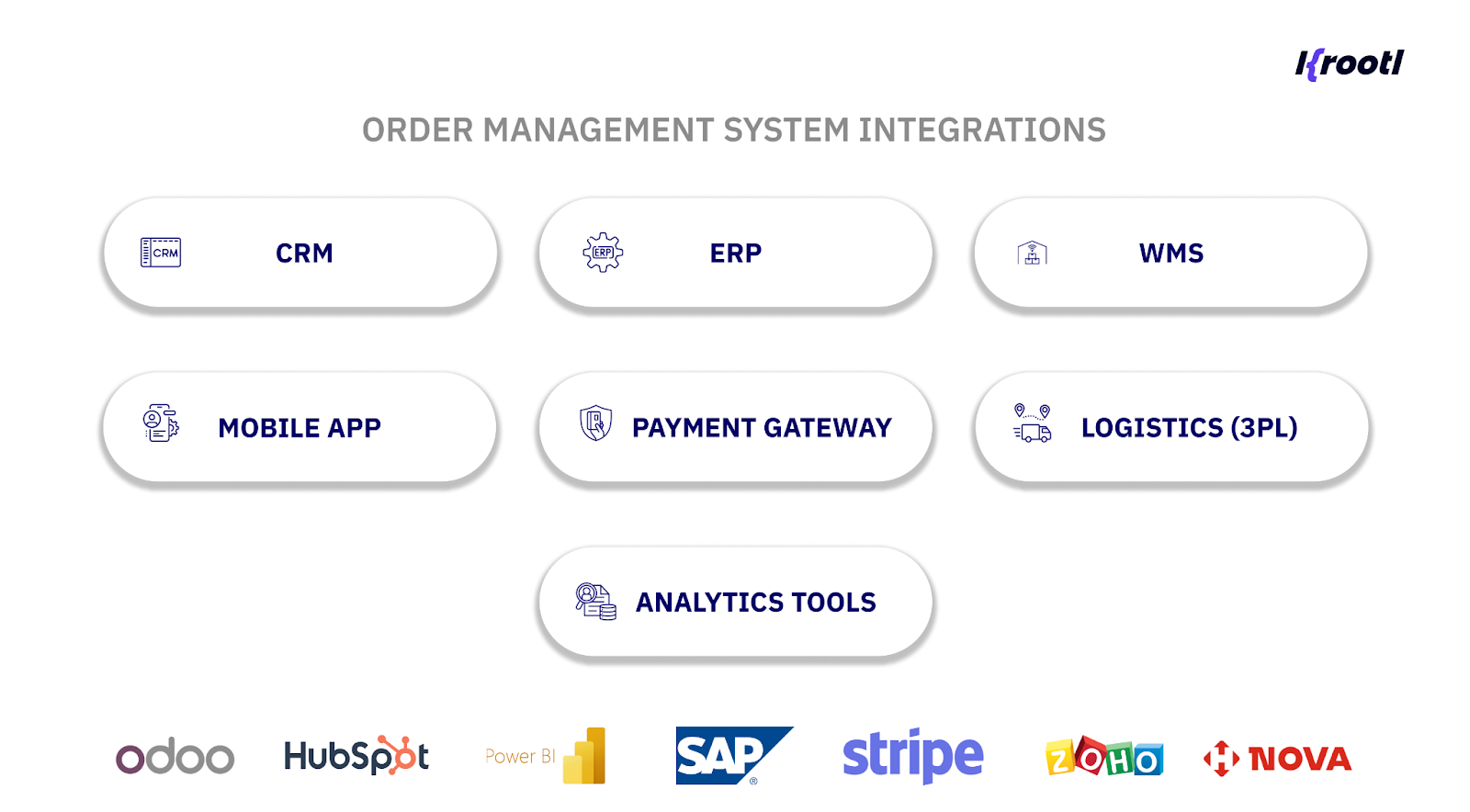
Below are the most valuable integrations to consider when planning your OMS development especially if you want to connect sales, fulfillment, and customer experience into a single, seamless flow.
CRM (Customer Relationship Management)
Why it matters: Syncing your OMS with a CRM like Salesforce or HubSpot gives sales and support teams full visibility into customer history, order status, and buying patterns. This integration supports better service, targeted upselling, and faster issue resolution.
ERP (Enterprise Resource Planning)
Why it matters: Linking your OMS with ERP systems like Odoo or SAP ensures your financial reporting, procurement, and inventory planning all stay aligned. This eliminates duplicate data entry and keeps your accounting accurate.
WMS (Warehouse Management System)
Why it matters: Integrating your OMS with a WMS boosts inventory accuracy, speeds up picking and packing, and reduces shipping errors. It’s essential for businesses managing their own warehouses or operating dark stores.
Payment Gateways
Why it matters: Connecting to gateways like Stripe or Adyen allows you to automate payment capture, refunds, and reconciliation. This is also critical for compliance with PCI DSS and fraud prevention.
Shipping & Logistics
Why it matters: Integration with carriers (DHL, UPS, NovaPoshta, or local couriers) lets you auto-generate labels, track deliveries in real time, and keep customers updated.
Related reading: How to develop a courier app
Analytics & BI Tools
Why it matters: Feeding your order data into platforms like Google Data Studio or Power BI gives you real-time insights into sales trends, product performance, and operational bottlenecks.
Mobile Apps for Field Teams or Drivers
Why it matters: A mobile order management app gives couriers, sales reps, and field service teams the ability to manage orders, update statuses, and capture signatures directly from a phone or tablet. This is especially effective when combined with delivery application development to cover last-mile fulfillment.
Must-Have Features in a Modern Custom Order Management System
While order management platforms can vary in complexity, some features are non-negotiable if you want to manage the full order lifecycle efficiently — from creation to fulfillment and beyond. When we develop a custom order management system, we make sure these capabilities are built in from the start, whether it’s a web platform, mobile order management app, or a cross-platform solution built with Flutter.
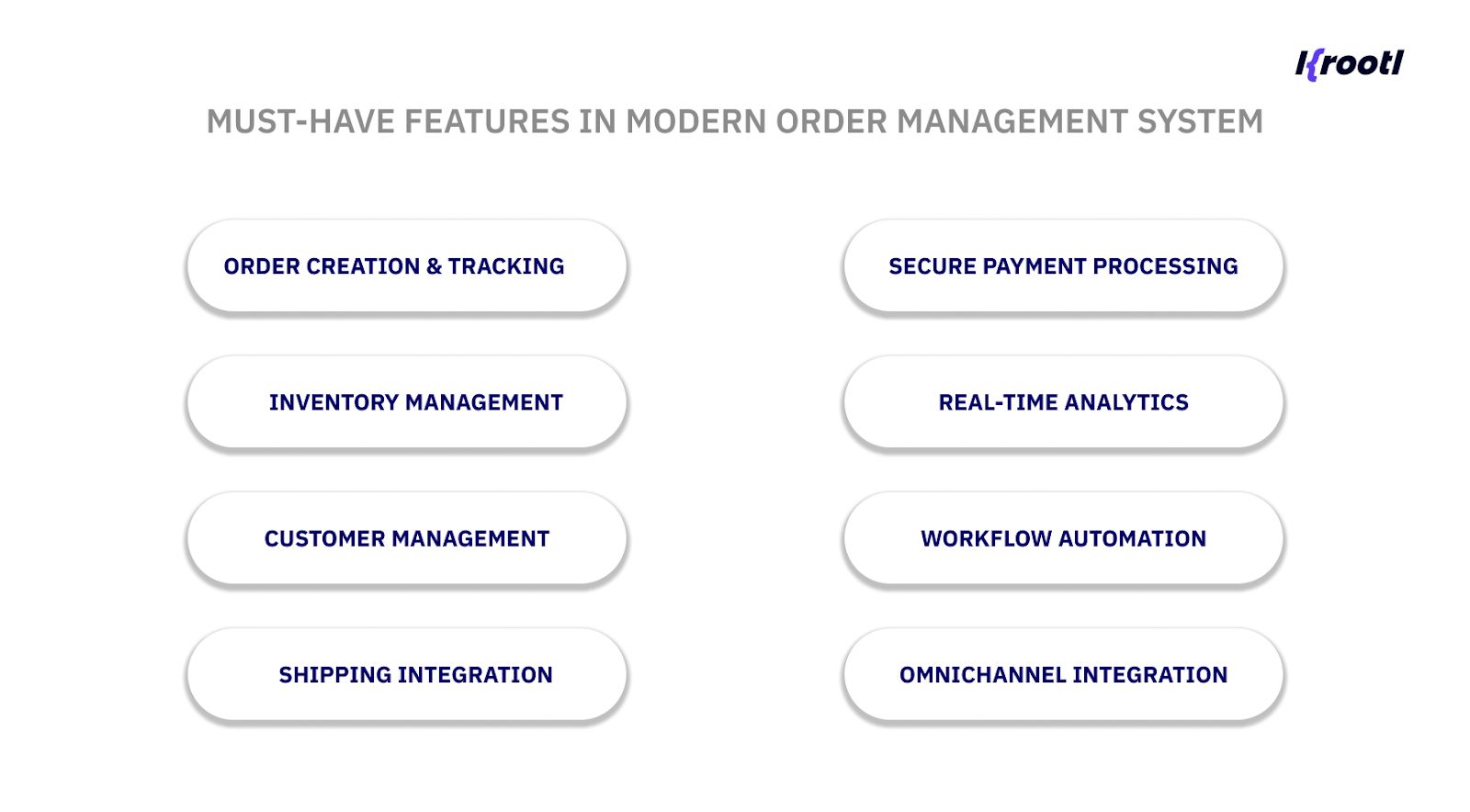
Order Creation & Tracking
Centralise all order activity from initial placement to final delivery so sales, support, and fulfillment teams have real-time visibility. This is essential for reducing errors and improving customer communication.
Multi-Location Inventory Management
Track stock across warehouses, stores, and fulfillment centers. Prevent overselling and automate stock updates as orders are processed.
Customer Management
Maintain detailed customer profiles, purchase history, and communication records to personalise service and support upselling.
Shipping Integration
Connect directly to carriers like FedEx, UPS, DHL, or local couriers to auto-generate labels, calculate rates, and update tracking without switching systems.
Secure Payment Processing
Integrate with payment gateways like Stripe or Adyen to handle transactions, apply taxes, and manage refunds securely within the OMS.
Real-Time Reporting & Analytics
Get instant insights into order volume, fulfillment times, returns, and revenue trends. This helps identify bottlenecks and plan more effectively.
Workflow Automation
Automate repetitive tasks such as sending status updates, triggering reorders, or generating invoices to save time and reduce human error.
Omnichannel & Multi-Channel Integration
Sync orders and inventory from multiple sales channels – web store, mobile app, marketplaces, and POS into a single system.
Here’s the rewritten “When It’s Time to Go Mobile” section with heavier SEO, smooth readability, and another article link included.
When It’s Time to Go Mobile with Your Order Management System
Not every business needs a mobile-first solution but for teams that operate outside a central office or warehouse, developing a mobile order management app can be a game-changer. Once your operations extend to delivery drivers, field sales reps, or retail floor staff, having real-time access to orders, inventory, and customer data on the go becomes critical.
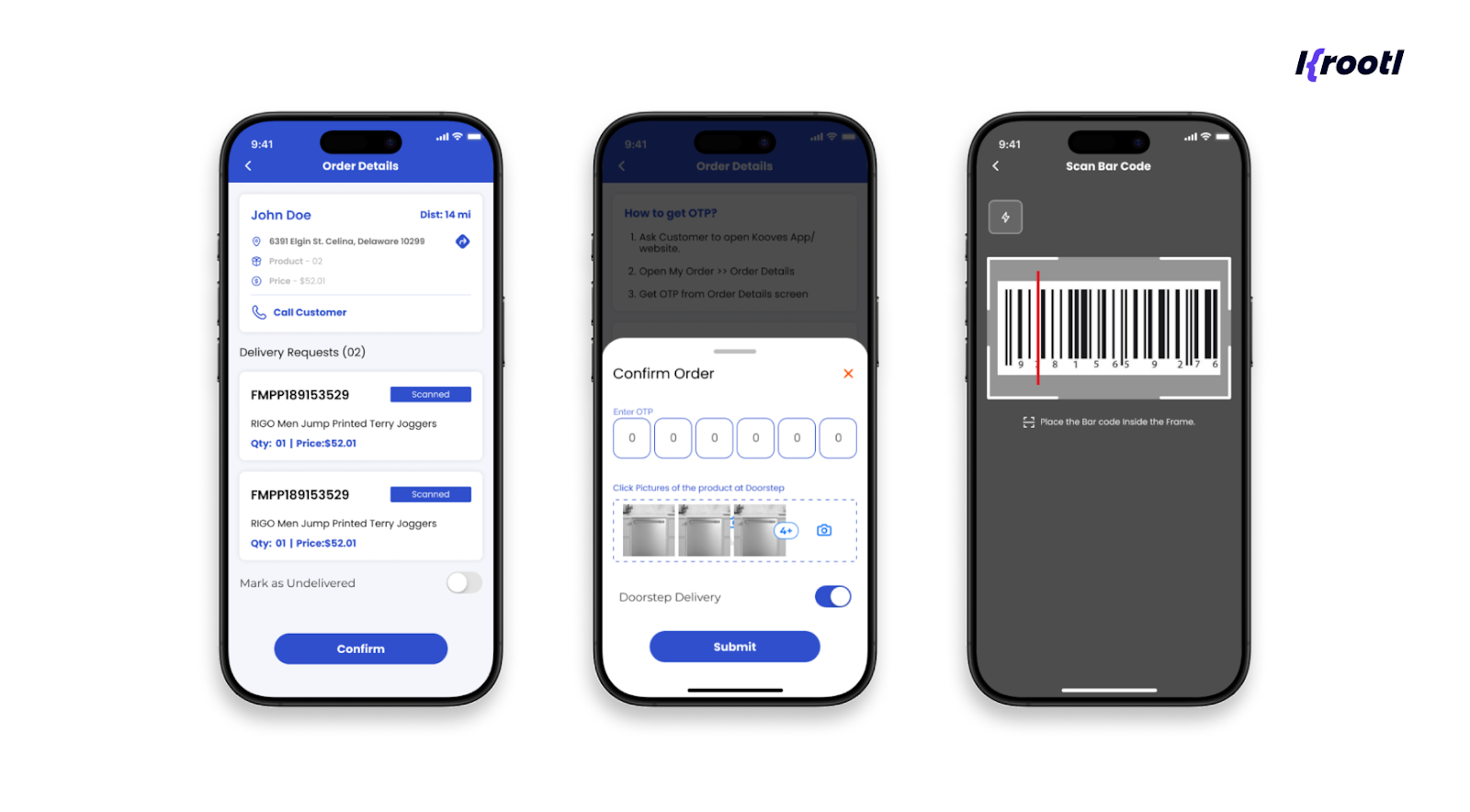
Here are some real-world scenarios where a mobile OMS delivers high ROI:
Delivery Services
Drivers can view order details, confirm deliveries, and update statuses directly from their smartphones — without calling dispatch or returning to base. Integration with your OMS ensures instant updates for both customers and internal teams.
See how we built a delivery application tailored for dark store chain
Field Sales Teams
Sales reps at trade shows, client meetings, or showrooms can create and edit orders on the spot, check inventory in real time, and send quotes instantly — all from a mobile phone or tablet.
Retail Stores
In-store staff can perform stock checks, process customer orders, or handle returns using a tablet. This reduces wait times and improves customer service.
Developing a mobile order management app also streamlines warehouse operations — from picking and packing to barcode scanning and shipment updates. With delivery application development in Flutter, you can build a single cross-platform app that works seamlessly on both Android and iOS devices.
How We Build a Custom Order Management System (Web + Mobile)
If you’ve decided to develop a custom order management system, understanding the development process will help you plan realistically and prioritise the features that matter most. At Krootl, we design and build custom OMS platforms for both web and mobile — often using Flutter for mobile order management app development so clients can launch on Android and iOS with a single codebase.
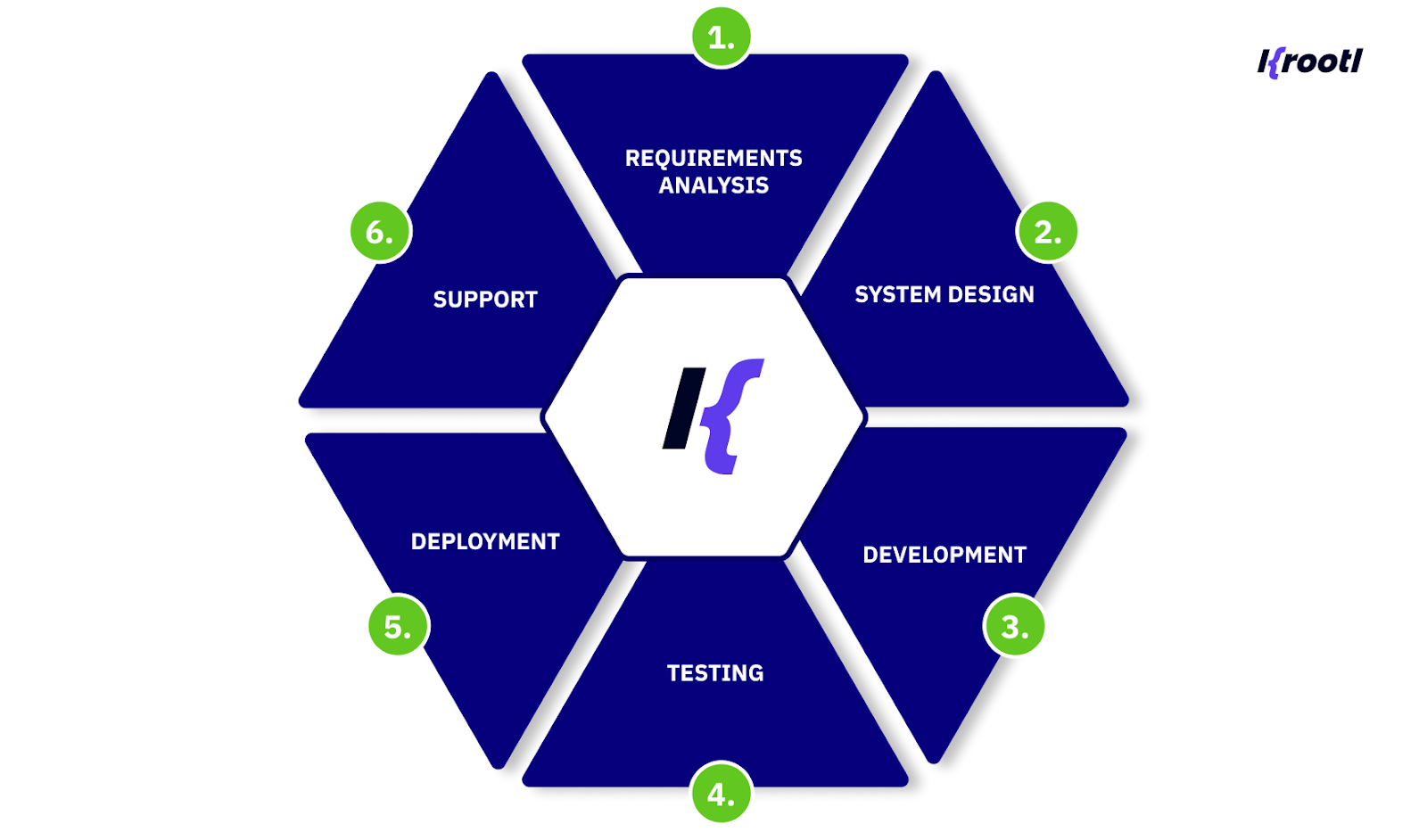
Here’s how our process typically works:
- Requirement Analysis
We start by identifying your business goals, target users (sales reps, warehouse staff, delivery drivers), and the challenges you want the OMS to solve. We also map out required integrations whether it’s ERP, CRM, payment gateways, courier applications, or inventory management systems.
- System Design
Our team creates the architecture blueprint, database structures, and UI/UX wireframes. If a mobile OMS is part of the scope, this is when we choose the right cross-platform approach (usually Flutter) to ensure performance, offline access, and a consistent user experience.
- Development
We build both the back-end (APIs, integrations, business logic) and the front-end (web dashboard and/or mobile app). With Flutter, a single codebase powers both Android and iOS OMS apps, reducing development time and maintenance costs.
- Testing
Before launch, we run rigorous manual and automated tests to verify performance, data accuracy, security, and integration stability.
- Deployment
Your OMS is deployed to the chosen cloud provider or on-premises environment. We provide training and onboarding so your team can start using it immediately.
- Ongoing Support
After the official launch, we monitor performance, gather user feedback, and implement improvements to keep your OMS efficient and aligned with business needs. This includes feature enhancements, new integrations, and workflow adjustments—ensuring your system evolves alongside your operations.
Related article: Building Your Own Mobile Delivery App: Step-by-Step Guide, see how our development approach applies to delivery and logistics apps.
Security & Compliance in Custom Order Management System Development
When we develop a custom order management system, security isn’t an afterthought — it’s built into every stage of the process. Any OMS that handles customer data, payment details, or inventory information must be secure by design to protect both your business and your customers.
At Krootl, we follow industry best practices to ensure that your custom OMS is robust, compliant, and future-proof:
- Data encryption in transit and at rest to prevent unauthorised access
- Role-based access control so team members only see what’s relevant to their job
- Secure API communication to protect data exchanged between systems
- Regular vulnerability testing to identify and fix potential risks before they become problems
We also ensure compliance with key regulations, including:
- GDPR for customer data privacy
- PCI DSS for secure payment processing
Whether you’re building an OMS that integrates with courier applications, supports delivery application development, or manages sensitive healthcare inventory, compliance and security are non-negotiable. By embedding these measures into the build, we create systems that not only meet current standards but are prepared for evolving regulations.
Here’s the rewritten Wrap-Up & CTA with heavier SEO, a clear closing hook, and a strong invitation to contact Krootl.
Wrap-Up: Why a Custom Order Management System Is Worth It
A modern order management system is more than a back-office tool — it’s the operational engine that keeps orders flowing, customers satisfied, and teams aligned. While off-the-shelf OMS platforms can be a quick start, they often limit flexibility, add licensing costs, and force your workflows to fit their structure.
A custom order management system, especially one with a mobile order management app built in, allows you to:
- Align the platform with exactly how your business operates
- Integrate with only the tools you need - from ERP to courier applications
- Avoid ongoing vendor fees by owning your code
- Scale smoothly as your order volume grows
Whether you’re managing a dark store, dispatching delivery drivers, or giving field sales teams real-time access to orders, the right OMS makes it all more efficient and profitable.
At Krootl, we’ve developed custom OMS solutions for FMCG brands, logistics companies, and retail businesses including courier app development, delivery application development, and mobile OMS apps for field teams.
Ready to develop an OMS that fits your business? Let’s talk about building a custom order management solution for you.












